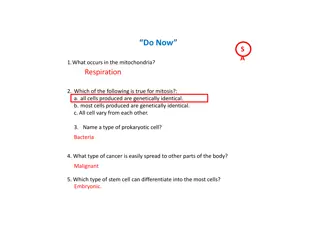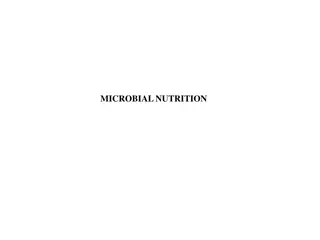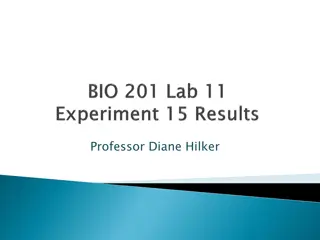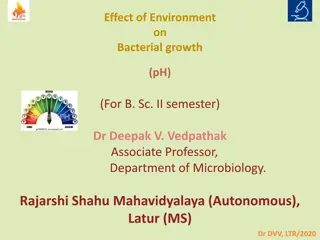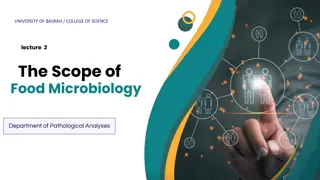Global biofertilizer market- Emerging trends and opportunities
The global biofertilizers market is segmented by microorganism type (nitrogen-fixing microbes, phosphate solubilizing & mobilizing microbes, potassium solubilizing & mobilizing microbes, other microorganism types), crop type (cereals & grains, oilseeds & pulses, fruits & vegetables, other crop types
1 views • 4 slides
Understanding Food Safety in Hospitality and Catering
Learners will explore food-related causes of ill health in hospitality and catering, including microbes and bacteria that can lead to food poisoning. Factors such as warmth, time, food supply, and moisture create ideal conditions for harmful bacteria to thrive and cause illness. This topic covers fo
5 views • 75 slides
Antimicrobial Susceptibility Testing Market
Antimicrobial susceptibility testing (AST) is a laboratory procedure to identify the right antimicrobial regimen against microbes. Thus, AST of the causative agent(s) is essential for the timely selection of appropriate antimicrobial therapy.
2 views • 3 slides
Precision Fermentation in Sustainable Food Production
Precision Fermentation is a specialized bioprocessing technique that utilizes microbes as cell factories to produce specific functional ingredients like proteins, vitamins, enzymes, and more. This innovative technology addresses the challenges of increasing food demands in a sustainable way, offerin
0 views • 12 slides
Understanding Bacterial Toxins and Cell Damage
Bacterial toxins are poisonous substances produced by microbes that can cause harm to host cells through direct damage, toxin production, and hypersensitivity reactions. Toxigenesis is a crucial mechanism used by bacterial pathogens to induce disease, with endotoxins and exotoxins playing distinct r
2 views • 28 slides
Our Beautiful Stinky Friends
Delve into the fascinating world of fermentation with chef/scientist David Zilber in this insightful listening guide based on the Science Friday podcast. Explore the science, ingredients, and techniques behind fermentation as Zilber shares his expertise and tips for home fermenters. Enhance your kno
0 views • 9 slides
Understanding Pesticide Chemistry and Their Importance in Agriculture
Pesticides are essential for controlling pests, diseases, and microbes that harm plants. They include insecticides, herbicides, rodenticides, bacteriocides, nematocides, molluscides, algicides, and fungicides. Integrated pest management is crucial for effective pest control in agriculture.
0 views • 89 slides
Genetic Control of Metabolism in Microbes: Enhancing Traits for Biotechnology
Exploring the genetic control of metabolism in microbes, focusing on wild type organisms and the process of strain improvement through mutagenesis, selective breeding, and recombinant DNA techniques. The potential benefits and challenges of altering microbial genomes for biotechnological application
0 views • 27 slides
Understanding the Immune System: Organs, Functions, and Importance
The immune system acts as a defense mechanism against pathogens and infections, comprising various organs, such as the bone marrow, thymus, spleen, white blood cells, antibodies, complement system, and the lymphatic system. It works to recognize and destroy harmful microbes, maintaining the body's h
1 views • 23 slides
The Role of Soil Microbes in Nutrient Recycling
Soil microbes such as bacteria, protozoa, and nematodes play a crucial role in nutrient recycling by breaking down organic matter, releasing nutrients for plant growth, and aiding in the decomposition process. These microscopic organisms help maintain soil health and ecosystem balance, highlighting
0 views • 16 slides
Safety Measures for Growing Microorganisms in the Laboratory
In the laboratory, it is crucial to use aseptic techniques when dealing with microorganisms to prevent contamination and ensure safe growth. Understanding the importance of agar plates, Petri dishes, and incubators in creating optimal conditions for microbial growth is essential. By following proper
0 views • 25 slides
Understanding Ecosystems and Disease Ecology
Explore the diverse types of ecosystems, including autochthonous, anthropurgic, and synanthropic ecosystems, and their impact on disease ecology. Learn about biotopes, biocenosis, ecological mosaics, and ecological interfaces, and discover how infectious diseases can be transmitted across these inte
0 views • 10 slides
Distillation Process for Purifying Water
Distillation is a method used to purify water by separating it from impurities through evaporation and condensation. It involves heating the water until it evaporates, then cooling the vapor to collect the purified water. This process ensures the removal of harmful substances and microbes, resulting
1 views • 11 slides
Understanding Our Environment: Class 6 Overview
The environment, derived from the French word "environ" meaning surrounds, encompasses both biotic (living) and abiotic (non-living) components. Biotic components include plants, animals, and microbes, while abiotic components consist of water, air, temperature, light, and soil. Plants are producers
1 views • 9 slides
Understanding Microbial Nutrition and Growth Factors
Microbes require carbon for metabolic activities, with organisms categorized as heterotrophs or autotrophs based on their carbon source. In addition to carbon, macronutrients like nitrogen, phosphorous, sulfur, potassium, and magnesium are crucial for cell function. Growth factors such as amino acid
0 views • 15 slides
Biofertilizers: Multiplication, Types, Advantages, and Applications
Biofertilizers play a crucial role in agriculture by harnessing live microbes to enhance soil fertility. They fix atmospheric nitrogen, solubilize phosphorus, and decompose organic wastes. Various types of biofertilizers exist, including carrier-based and liquid forms, each with its own advantages a
0 views • 18 slides
Understanding Metabolic Pathways in Microbes
Metabolism in living organisms involves anabolism and catabolism, where anabolism generates essential biomolecules for growth using energy, while catabolism breaks down nutrients for energy release. Anabolic processes include synthesis of carbohydrates, lipids, proteins, nucleic acids, and other gro
7 views • 24 slides
Understanding Wound Infections: A Comprehensive Overview
Explore the various stages of wound infections on a continuum from contamination to systemic infection. Learn how to identify and manage each stage, from presence of microbes to invasion of surrounding tissues. Discover the subtle signs of local and spreading infections, and the serious implications
1 views • 30 slides
Understanding Radiation Pollution and Its Effects
Radiation pollution, whether ionizing or non-ionizing, is a significant environmental concern. Ionizing radiation can penetrate tissues and cause damage to living cells, while non-ionizing radiation may effectively sterilize microbes. Sources of radiation include cosmic rays, terrestrial elements li
0 views • 15 slides
Understanding Normal Human Microbiota and Its Role in Health
Normal human microbiota refers to the microorganisms residing on our skin and mucous membranes, playing vital roles in digestion, immunity, and protection against pathogens. They are categorized into resident and transient groups, with resident flora aiding in maintaining health by synthesizing nutr
0 views • 28 slides
Understanding Microbiology: An Introduction to the World of Microorganisms
Microbiology, the study of microorganisms, encompasses the history, branches, classification, and importance of microbes. From prokaryotes to eukaryotes, this field delves into the realm of tiny life forms invisible to the naked eye. Explore the rich history of microbiology, its branches, and the wi
1 views • 35 slides
History of Chemotherapy: From Empirical Use to Modern Era
The history of chemotherapy is divided into three phases, starting from the empirical use of compounds in ancient times to the modern era marked by targeted drug development. Ehrlich's pioneering work in the late 19th to early 20th centuries laid the foundation for understanding the selective toxici
0 views • 15 slides
Understanding Composting and Vermicomposting Technology
Composting and vermicomposting are controlled decomposition processes of organic materials, with aerobic microbes breaking down the matter in the presence of oxygen. Aerobic composting produces stable humus and helps eliminate pathogens and weed seeds. The processes involve microbial respiration, ga
1 views • 29 slides
Understanding Respiratory Hygiene: Key Stage 1 Learning Activity
Explore the importance of respiratory hygiene and how harmful microbes can spread through coughs and sneezes. Learn about good respiratory hygiene practices to prevent infection and engage in a hands-on learning activity to understand the concept better. This educational material is designed for Key
0 views • 17 slides
Importance of Hand Hygiene for Preventing Infections
Understanding the importance of hand hygiene is crucial in preventing the spread of infections. This educational material emphasizes the significance of washing hands to remove harmful microbes and prevent illnesses. Through learning outcomes, curriculum links, and engaging activities like observing
0 views • 35 slides
Importance of Hand Hygiene in Preventing Spread of Germs
Understand the significance of hand hygiene in removing microbes and preventing illnesses. Learn why washing hands with soap and water is essential, explore engaging experiments, and discuss points related to hand washing. Discover the sources of microbes on hands and the necessity of washing hands
1 views • 19 slides
Importance of Hand Hygiene and Understanding Microbes in Preventing Illness
Exploring the significance of hand hygiene and knowledge of microbes in reducing the spread of infections. Learn about helpful and unhelpful microbes, how they can make you ill, and the ways unhelpful microbes enter the body, emphasizing the importance of proper handwashing and hygiene practices.
1 views • 10 slides
Preventing the Spread of Infection Through Respiratory Hygiene
Understand how infections spread through coughs and sneezes, the importance of covering your mouth and nose, and how microbes can be passed from person to person. Learn about the main activities and ways to reduce the spread of infection through good respiratory hygiene practices.
0 views • 26 slides
Surgical Skin Preparation: Importance and Best Practices
Surgical skin preparation is crucial to reduce microbes and prevent surgical site infections. It involves thorough cleansing to eliminate dirt, oils, and microbes while minimizing the risk of infection. Methods include mechanical friction and using antiseptic solutions like alcohol, iodine, and chlo
0 views • 34 slides
Discover BioWaveTM: Innovative Bioaugmentation Solution for Water Treatment
Utilize BioWaveTM, a cutting-edge bioaugmentation solution, to enhance microbial populations in water systems for efficient breakdown and digestion of organic waste. Learn about its application in septic systems, grey water treatment, and ponds/aquaria, and explore the benefits of beneficial microbe
0 views • 26 slides
Understanding Useful Microbes: Key Information for Students
Explore the world of useful microbes, learning how they benefit us in areas such as health, food production, and waste recycling. Discover how microbes like bacteria and fungi play essential roles in various processes, from antibiotic production to fermentation. Engage in activities to deepen your u
0 views • 18 slides
Food Safety and Preventing Food-borne Illness
This lesson focuses on the importance of food safety, addressing how clean our food is and at what points safety can be compromised. It delves into common types of microbes that contaminate foods and explores ways in which food safety can be compromised. The activity involves case studies on food sa
0 views • 11 slides
Understanding Cell Injury and Degeneration in Response to Various Stressors
Cell injury can result from multiple stressors such as hypoxia, physical agents, chemicals, microbes, immunologic factors, nutritional imbalances, and aging. This can lead to reversible changes (degeneration) or irreversible changes (necrosis). Types of degeneration include cloudy swelling, hydropic
0 views • 22 slides
Microbiology Laboratory Experiments Overview
This overview showcases various microbiology laboratory experiments conducted to examine the physiology of bacteria, enzymatic activities, and biochemical reactions. It includes experiments on Phenol Red Dextrose Broth, Phenol Red Lactose Broth, Nitrate Broth, Tryptone Broth, and more. The provided
0 views • 26 slides
The Importance of Microbes in Our World
Microbes, tiny organisms invisible to the naked eye, play crucial roles in various ecosystems. They are found abundantly in soil, air, and even inside buildings. Microbes aid in nitrogen conversion for plant growth, photosynthesis, decomposition, and food production. Without microbes, life on Earth
0 views • 19 slides
Pure Culture Preparation by Streak Plate Method
Bacteria often exist in mixed populations, making it essential to isolate them for studying their characteristics. The streak plate method, involving streaking nutrient agar and incubating, helps in obtaining pure cultures of individual species. This method facilitates the observation of isolated co
0 views • 5 slides
pH Effects on Bacterial Growth: The Influence of Environment
This study explores the impact of pH levels on bacterial growth, highlighting the minimum, optimum, and maximum pH requirements for different categories of microbes - acidophiles, neutrophiles, and alkaliphiles. It delves into the consequences of pH variations on cellular processes like DNA stabilit
0 views • 8 slides
Exploring the Fascinating World of Food Microbiology and Microbial Habitats
Delve into the intriguing realm of food microbiology, uncovering how fermentation microbes can positively influence food properties, the importance of microbiological quality assurance, and the diverse habitats where microorganisms thrive. Learn about the impact of microflora on food quality and saf
0 views • 7 slides
Exploring Micro-organisms in Key Stage 1 Curriculum
Discovering the world of micro-organisms is essential in Key Stage 1 education. Students learn about the different types of microbes, their shapes and sizes, and how they can be both harmful and beneficial. Through interactive activities like modelling microbes, students explore the role of viruses,
0 views • 24 slides
Exploring Microbial Diversity: Fungi in Microbiology
Microbes are vital single-celled organisms that exist everywhere, some beneficial while others harmful. Fungi, a crucial group of microbes, can be unicellular or multicellular, with diverse roles in nature and human activities. This article delves into the characteristics and classification of fungi
0 views • 15 slides
